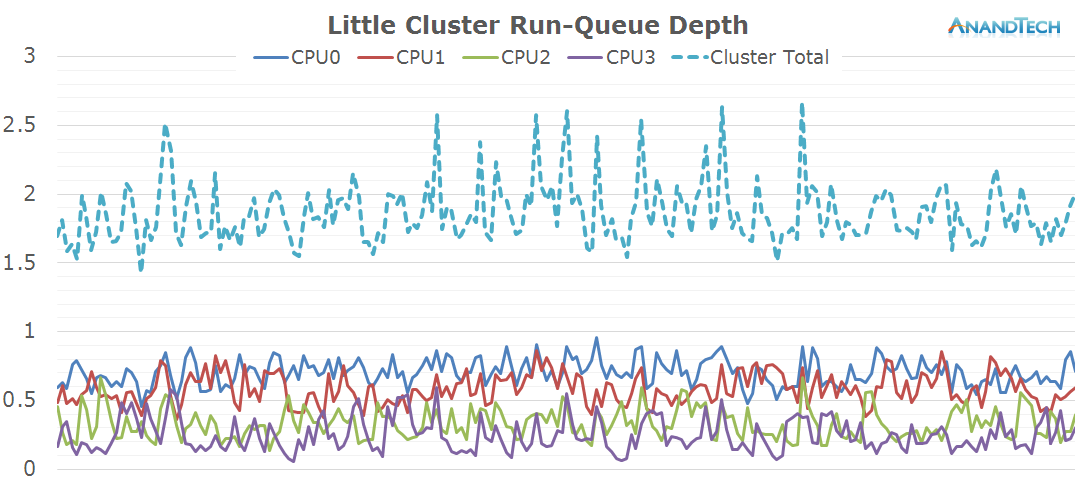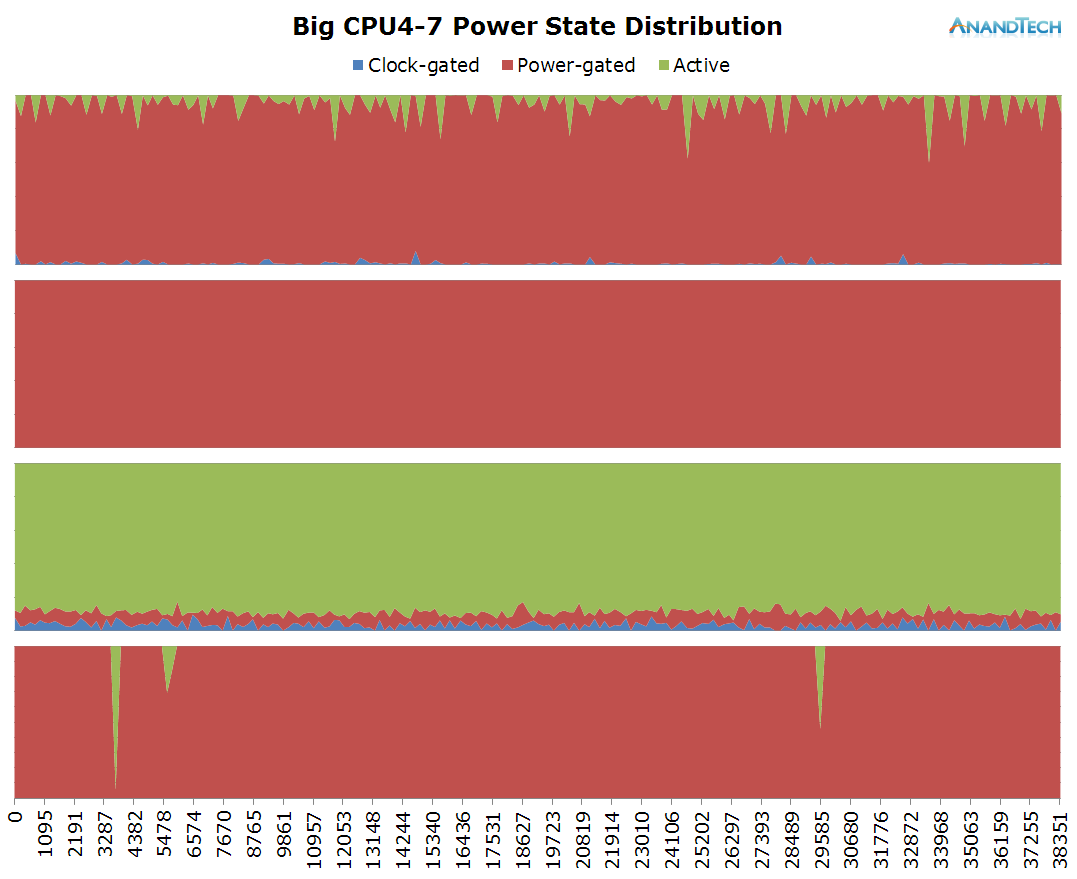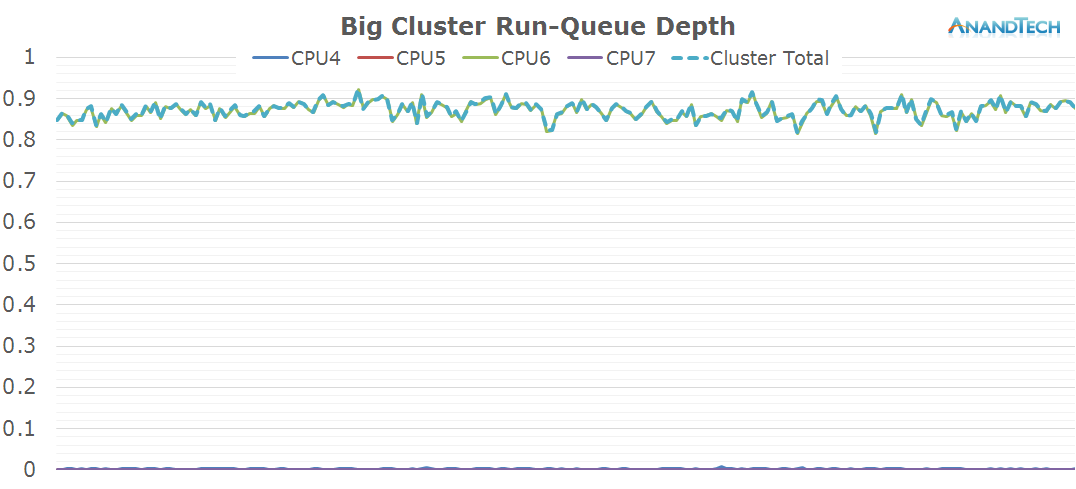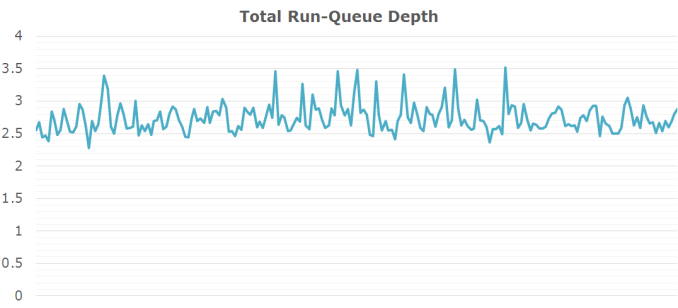The Mobile CPU Core-Count Debate: Analyzing The Real World
by Andrei Frumusanu on September 1, 2015 8:00 AM EST- Posted in
- Smartphones
- CPUs
- Mobile
- SoCs
Real Racing 3 Playing
The little cores see at least 3 major threads loaded onto them. The 4th core is doing some work as well, but quite a bit less than the first 3. What is extremely interesting here is the frequency distribution graph: The cores don't settle for any one frequency and make use full use of the full range of the cluster.
The behaviour of the big-cluster is clear-cut. There's only 1 significant thread that ever gets placed on the big cores. This is an ideal scenario for a big.LITTLE architecture as would there have been more than 1 thread, that secondary thread would have suffered from diminished efficiency as it wouldn't be able to run at the best perf/W frequency due to ARM's synchronous frequency planes between CPUs in a cluster.
The power-distribution graph does show the worrying anomaly of seeing CPU4 come out its power-collapse state for very small periods of time. This would be a source of inefficiency of either the scheduler or the CPUIdle framework needing to wake up that core for the sake of simple clean-up work instead of real load.
I think it's pretty safe to come to the conclusion that Real Racing 3 is coded with quad-core CPUs in mind as we see exactly 4 major threads loading the SoC's CPUs to various extent.

















157 Comments
View All Comments
lilmoe - Tuesday, September 1, 2015 - link
"if the interest is high enough":/ Really?
zaza - Saturday, September 5, 2015 - link
Yes Please. It would be nice to see if the same or similar tests works on snaprdagon 810,801 and 615 and Mediatek chips, and intel SoCerchni - Thursday, September 17, 2015 - link
A follow-up with synthetic would be quite interesting.aryonoco - Saturday, September 5, 2015 - link
I just wanted to reiterate the point here an thank the author for this great piece of technical investigative journalism.Andrei, thank you for this work. It is hugely invaluable and insightful.
tipoo - Tuesday, September 1, 2015 - link
Very interesting article. Seems like the mantra of "more cores on mobile are just marketing" was wrong in terms of Android, seems to dip into both four core big and little clusters pretty well. That puts the single thread performance having lagged behind the Apple A series (up until the S6 at least) in a new light, since it can in fact use the full multicore performance.tipoo - Tuesday, September 1, 2015 - link
*That is, barring gaming. More core Android functions do well with multithreading though.jjj - Tuesday, September 1, 2015 - link
In gaming there is a big advantage. By using mostly the small cores you allow for more TDP to go to the GPU. One more relevant thing would console ports in the next couple of years when mobile GPUs will catch up with consoles. The current consoles have 8 small cores and that fits just right with many small cores in Android.retrospooty - Tuesday, September 1, 2015 - link
Not really sure whos "mantra" that was. People that don't understand what the big.little architecture is like some angry Apple fans?tipoo - Tuesday, September 1, 2015 - link
Well sure, whoever they were, but it was a pretty common refrain for every 8 core SoC.soccerballtux - Tuesday, September 1, 2015 - link
for one, it was my mantra. I liked having 4 cores because 2 wasn't enough, but according to my hotplugging times, I only really need 3 for optimal experience most of the time